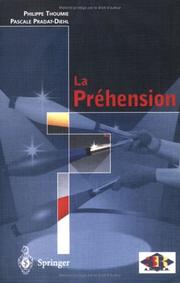| Listing 1 - 4 of 4 |
Sort by
|
Book
Year: 2001 Publisher: Bruxelles: UCL,
Abstract | Keywords | Export | Availability | Bookmark
 Loading...
Loading...Choose an application
- Reference Manager
- EndNote
- RefWorks (Direct export to RefWorks)
Congenital brain lesions lead to an intricate ensemble of deficits, commonly referred to as cerebral palsy (Bax, 1964 ; Volpe, 1997). Although cerebral palsy (CP) may be associated with moderate cognitive dysfunction, the most invalidating neurological deficits usually arise from acoricospinal tract lesion yielding spastic quadriparesis, diplegia or congenital hemiplegia. Different animal experiments have suggested that early brain lesions usually lead to less detrimental functional consequences than comparable lesions acquired in adulthood. The situation is, however, more complex in CP children probably because of the large variability in size, location and pathogenesis of brain lesions and, in spite of an apparent anatomical similarity, early corticospinal lesions may have spectacularly variable functional outcome (Volpe, 1997, 2000 : Olsen et al., 1997).
The impaired dexterity observed in CP children is partly due to spasticity and musculoskeletal malformations, but more importantly, the neural control of finger movements is altered in these patients. Indeed, skilled independent finger movements do not develop properly in CP children and careful investigations of the grip-lift synergy have permitted a quantitative analysis of their impaired dexterity (Forssberg et al., 1999). The grip-lift movement consist of lifting an object between the thumb and index finger (precision grip). In normal adult subjects, the grip-lift synergy is characterized by a parallel increase in grip force (the force normal to the grip surface) and load force (the vertical lifting force) (Westling and Johansson, 1984). The anticipatory generation of these two forces suggests the existence of an internal representation of the physical properties (size, weight, friction) of the object acquired during earlier manipulation or training (Johansson and Westling, 1987, 1988 ; Gordon et al., 1991a,b,c, 1992Forssberg et al., 1995). In addition the anticipatory control of the grip and load forces leads to a well-controlled vertical acceleration because of an optimal load force-rate at lift-off. In contrast, young children are not able to use this feed-forward strategy before the second year of life. Instead, they rise both forces stepwise in an asynchronous manner, leading to multiple force rate pulses before lift-off. This behaviour reveals a feed-back strategy, based on sensory information, instead of a feed-forward strategy. Gradually during the development children develop a bell- shaped force-rate profile and an anticipatory control of both forces. By the age of eight, children show a grip-lift synergy identical to that found in adults (Forssberg et al., 1992) ; this parallels the development of manual skills (Forssberg et al., 1991). The increased manual skill occurring during the development may partly reflect the maturation of both cortical areas and corticospinal pathway necessary to execute precise finger movements (Forssberg et al., 1999).
CP children usually never develop a normal coordination between the grip and load forces (Eliasson et al., 1991, 1992 ; Gordon et al., 1999). Instead they produce a sequential onset of both grip and load forces and show multi-peaked force-rate profiles, with several irregular peaks unrelated to lift-off. As a consequence, CP children exhibit prolonged delays between the different movements phases of the grip-lift synergy and their pattern of movement is reminiscent of that observed in one year-old children. The poor development of the grip-lift synergy in CP children is due to cortical and subcortical lesions involving the corticospinal system. Recently, a careful analysis of the grip-lift synergy in CP children has permitted to establish a correlation between hand function recovery and both the extent and location of the lesion (Forssberg et al., 1999). However, Forssberger et al. (1999) did not study the correlation between each grip-lift synergy variables and hand dexterity. Moreover, they did not investigate the correlation between the corticospinal tract degeneration and hand function.
The aim of the present study was to correlate both the grip-lift synergy and the hand dexterity in CP children. Firstly, we investigated whether one single variable in the grip-lift synergy was correlated with hand dexterity and could be used to characterize hand deficit in CP children. Secondly, we correlated the hand dexterity with both the lesion location and the importance of the resulting Wallerian degeneration of the corticospinal tract. This approach could be used to predict the functional outcome of CP children before motor deficits become apparent
Book
ISBN: 9782840234258 2840234254 Year: 2005 Publisher: Montpellier: Sauramps médical,
Abstract | Keywords | Export | Availability | Bookmark
 Loading...
Loading...Choose an application
- Reference Manager
- EndNote
- RefWorks (Direct export to RefWorks)
Hand --- Hand Strength --- Anatomy, Comparative
Dissertation
Year: 2000 Publisher: Liège : Université de Liège. Faculté de médecine (ULg). Département de clinique et pathologie médicales,
Abstract | Keywords | Export | Availability | Bookmark
 Loading...
Loading...Choose an application
- Reference Manager
- EndNote
- RefWorks (Direct export to RefWorks)
MEDIAN NERVE --- CARPAL TUNNEL SYNDROME --- HAND STRENGTH --- MEDIAN NERVE --- CARPAL TUNNEL SYNDROME --- HAND STRENGTH

ISBN: 2287597026 9782287597022 Year: 2000 Publisher: Paris Springer
Abstract | Keywords | Export | Availability | Bookmark
 Loading...
Loading...Choose an application
- Reference Manager
- EndNote
- RefWorks (Direct export to RefWorks)
Physiotherapy. Alternative treatments --- kinesitherapie --- Orthopaedics. Traumatology. Plastic surgery --- orthopedie --- Hand Strength --- Grip strength --- Préhension --- Préhension --- Hand Strength.
| Listing 1 - 4 of 4 |
Sort by
|

 Search
Search Feedback
Feedback About UniCat
About UniCat  Help
Help News
News